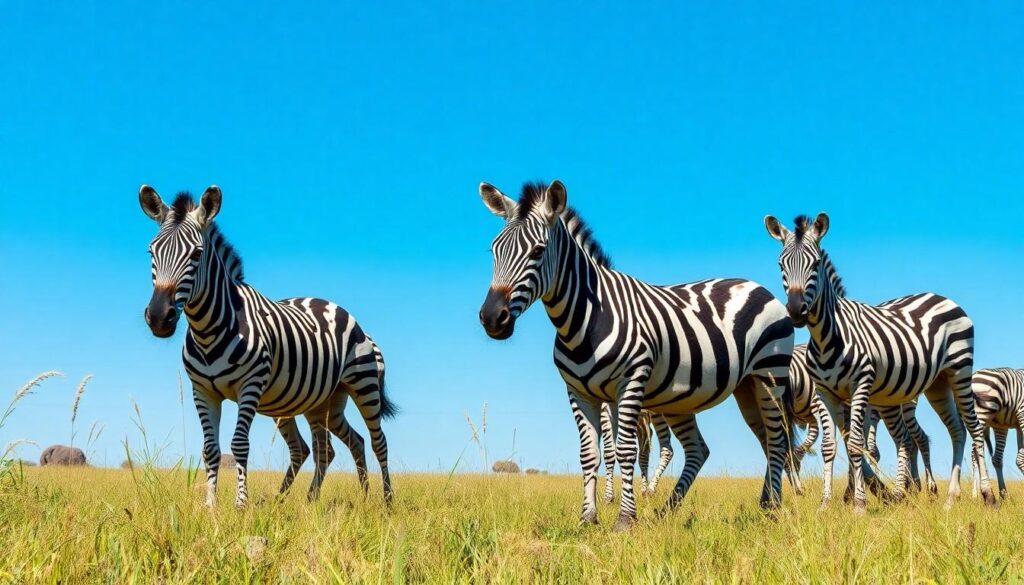When it comes to the magnificent black-and-white striped creatures that roam the African plains, we’re often captivated by their unique appearance. But have you ever wondered about zebra names? These fascinating animals deserve monikers that match their distinctive personalities and striking patterns.
We’ve gathered an exceptional collection of zebra names that range from cute and playful to strong and majestic. Whether you’re naming a pet, a stuffed animal, a character in a story, or simply satisfying your curiosity about what people call these stunning equids, our comprehensive guide has you covered. Join us as we discover the area of zebra nomenclature and discover the perfect name for these iconic striped beauties.
Why Zebras Need Unique Names: Understanding Their Individual Patterns
Did you know that zebra stripes are as unique as human fingerprints? Each zebra possesses a distinctive pattern that differentiates it from others in the herd. These unique stripe configurations serve as nature’s identification system, allowing zebras to recognize each other within their social groups.
Scientists have documented that no two zebras share identical stripe patterns, making them truly individual animals. Their stripes function as a natural barcode, with variations in width, spacing, and direction creating a one-of-a-kind visual signature for each animal.
Recognition plays a crucial role in zebra herds, especially between mothers and foals. A mother zebra memorizes her baby’s exact stripe pattern shortly after birth, helping her locate her foal within the chaotic movement of the herd during migration or when escaping predators.
Zoologists studying wild zebra populations often name individual animals based on their stripe patterns to track them over time. Names like “Lightning” for zebras with zigzag patterns or “Checkers” for those with particularly blocky stripes help researchers monitor exact animals throughout their studies.
Conservation efforts benefit tremendously from identifying and naming individual zebras. Tracking named individuals allows scientists to monitor population health, movement patterns, and reproductive success across generations.
Modern technology has enhanced our ability to recognize individual zebras through specialized software that analyzes stripe patterns, similar to facial recognition systems used for humans. These programs can identify thousands of individual zebras with remarkable accuracy, further demonstrating the uniqueness of each animal’s pattern.
10 Popular Zebra Names Inspired by Their Distinctive Stripes

Looking for the perfect name for a zebra that highlights their unique striped pattern? Here are ten popular names that celebrate their distinctive black and white markings.
- Stripey – This straightforward name puts the zebra’s most recognizable feature front and center, making it a popular choice for both males and females.
- Marble – Reminiscent of the elegant swirls in marble stone, this name beautifully captures the zebra’s contrasting black and white pattern.
- Checkers – Inspired by the classic board game, this playful name references the zebra’s alternating dark and light markings.
- Oreo – Just like the beloved cookie, this name reflects the perfect balance of black and white that makes zebras so visually striking.
- Zippy – This energetic name complements the zebra’s quick movements while subtly nodding to their “zippered” appearance.
- Ziggy – Playful and fun, this name evokes the zigzagging pattern of stripes that run across a zebra’s body.
- Dottie – While zebras have stripes rather than dots, this cute name works well for a zebra with a particularly spotty personality.
- Pepper – Inspired by the speckled appearance of black and white peppercorns, this name offers a spicy alternative to more obvious stripe references.
- Misty – Soft and ethereal, this name suggests the sometimes dreamy, hazy appearance of a zebra’s stripe pattern from a distance.
- Snowflake – Celebrating the uniqueness of each zebra’s stripe pattern, this name reminds us that no two zebras look exactly alike.
Stripe-Related Names for Male Zebras
Male zebras deserve names that highlight both their striking appearance and masculine energy. Stripey makes an excellent choice for a straightforward, descriptive name that directly references his distinctive markings. Ziggy offers a more playful alternative that captures the lively spirit many male zebras possess. Marble provides an elegant option that evokes the sophisticated swirls found in marble stone. Checkers brings a game-inspired name that suits an intelligent and strategic male zebra. Oreo rounds out the top choices for males with its sweet association and perfect description of the black and white contrast.
Stripe-Related Names for Female Zebras
Female zebras can sport names that combine femininity with references to their beautiful striped coats. Stripey works equally well for females, offering a simple yet effective description of their most notable feature. Marble gives female zebras an elegant name option that suggests grace and beauty in their patterned appearance. Dottie provides a cute alternative that hints at a personality full of character and charm. Pepper brings a touch of spice to a female zebra’s identity, inspired by the distinctive black and white speckling of peppercorns. Misty completes the top names for females with its soft, mysterious quality that perfectly describes the dreamlike quality of a zebra’s stripes from afar.
8 African-Origin Zebra Names That Honor Their Native Habitat

Traditional Names from East African Languages
The rich linguistic heritage of East Africa offers authentic names for zebras that connect deeply to their homeland. In Swahili, Grévy’s zebra is known as “Pundu Kubwa,” which translates to “large zebra,” acknowledging their status as the largest living wild equid. Plains zebras are called “Pundu Mlia” in Swahili, distinguishing them from other species while maintaining the core “pundu” reference that identifies them as zebras. Local communities have developed these descriptive terms over generations, creating a naming system that reflects both the animals’ appearance and their significance in regional ecosystems. These traditional names carry cultural importance and showcase how indigenous knowledge systems classify and honor wildlife.
Names Reflecting African Landscapes
African industry-inspired names capture the essence of zebras’ natural habitats and historical context. “Quagga,” derived from the Khoikhoi language of southern Africa’s indigenous people, refers to a now-extinct subspecies of plains zebra that once roamed South Africa in vast numbers. “Burchell’s Zebra” honors British explorer William John Burchell while connecting the animal to its discovery context in the African savanna. “Grant’s Zebra,” named after British explorer Robert Grant, specifically refers to subspecies found in East Africa, highlighting regional biodiversity. “Chapman’s Zebra” commemorates English explorer James Chapman, while “Selous’ Zebra” recognizes Frederick Selous, a British explorer whose name is forever linked to southern African wildlife. These names elegantly combine historical exploration with geographical specificity, preserving connections between zebras and their native African landscapes.
7 Celebrity Zebra Names from Zoos and Wildlife Parks Around the World

Just like human celebrities captivate our attention, certain zebras have gained fame and recognition in zoos and wildlife parks globally. These striped ambassadors help educate the public about conservation while charming visitors with their unique personalities.
Famous Conservation Ambassador Zebras
Conservation ambassador zebras play a crucial role in educating the public about wildlife preservation efforts. Kibo, meaning “gift” in Swahili, represents the Grevy’s zebra (Equus grevyi) at several conservation-focused facilities, highlighting this endangered species’ plight. Jafari, whose name translates to “courageous” in Swahili, serves as a prominent ambassador for mountain zebras (Equus zebra), helping visitors understand their habitat needs. Nala, meaning “success” in Swahili, represents plains zebras (Equus quagga) in educational programs that emphasize their importance in African ecosystems. Tatu, Swahili for “three,” often identifies zebras with distinctive triple-pattern markings that make them excellent visual examples of zebra uniqueness. Safari has become a popular name for zebras involved in conservation outreach programs, creating an immediate connection to their natural habitat.
Beloved Zoo Resident Names
Zoo residents often receive names that reflect their personality traits or physical characteristics. Zoe has become a favorite name for playful and energetic female zebras that engage actively with enrichment activities. Stripey, though seemingly obvious, remains among the most popular names given to zebras by zoo visitors during naming contests. Oreo frequently tops the list for zebras with particularly bold black and white markings, referencing the iconic cookie’s similar color pattern. Ziggy has emerged as a preferred name for male zebras, particularly those with unusual zig-zag pattern variations in their stripes. Marble aptly describes zebras whose stripe patterns swirl in unique formations, making them stand out even among their distinctively patterned species. Zippy often identifies particularly fast-moving zebras that demonstrate their species’ natural speed during habitat demonstrations. Pepper, with its black and white connotation, serves as a fitting name for male zebras with especially speckled patterns where their stripes meet.
6 Mythical and Fictional Zebra Names from Books and Movies

Fictional zebras have captured our hearts through various books, movies, and TV shows. These characters often display unique personalities and adventures that make them memorable. Here are six famous fictional zebras that have become cultural icons:
Marty
Marty from the “Madagascar” movie series stands out as one of the most recognizable fictional zebras in popular culture. This adventure-seeking zebra dreams of exploring the industry beyond his zoo enclosure, eventually leading his friends on a wild journey. His witty personality and search for freedom resonate with audiences of all ages.
Stripes
Racing Stripes features the ambitious zebra named Stripes who believes he’s actually a horse. This determined character dreams of competing in professional horse races even though his obvious physical differences. His inspiring story teaches viewers about pursuing dreams regardless of limitations or others’ expectations.
Zecora
Zecora appears in the “My Little Pony” series as a wise and mysterious zebra living in the Everfree Forest. Known for her magical abilities and speaking in rhymes, Zecora offers guidance to the main characters. Her character introduces young viewers to concepts of cultural differences and the importance of not judging others by appearances.
Zigby
Zigby serves as the protagonist in the children’s TV series bearing his name. This young zebra embarks on various adventures with his friends while learning valuable life lessons along the way. The show’s educational focus helps children develop problem-solving skills through Zigby’s experiences.
Zelda
Zelda the Zebra appears in various children’s books including her self-titled series. Her character typically explores themes of friendship, self-acceptance, and adventure. Children’s literature often uses zebra characters like Zelda to teach important social and emotional lessons.
Zigzag
Zigzag from “The Thief and the Cobbler” movie presents a unique take on zebra characters in animation. With distinctive visual design and personality traits, Zigzag adds to the diverse representation of zebras in fictional media. This character demonstrates how zebras have been adapted into various storytelling contexts beyond realistic portrayals.
5 Scientific Naming Conventions for Zebra Species and Subspecies

1. Genus Classification
Zebras belong to the genus Equus, which encompasses horses and asses as well. All zebra species share this taxonomic classification within the family Equidae, reflecting their evolutionary relationship with other equines. Scientists use this classification as the foundation for zebra nomenclature, establishing their place in the broader taxonomic hierarchy of mammals.
2. Species Designation
The scientific community recognizes three distinct zebra species, each with its own scientific name:
- Plains Zebra: Equus quagga is the current scientific name for this most common zebra species. Previously known as Equus burchelli, this name changed after genetic studies confirmed the extinct quagga was actually a subspecies of plains zebras.
- Grevy’s Zebra: Equus grevyi designates this largest and most endangered zebra species.
- Mountain Zebra: Equus zebra identifies this species adapted to rocky, mountainous habitats.
3. Subspecies Nomenclature
Zebra taxonomists use trinomial nomenclature to identify exact subspecies within each zebra species:
- The extinct quagga is now classified as Equus quagga quagga, recognizing it as a subspecies of plains zebras rather than a separate species.
- Mountain zebras include two main subspecies: Cape mountain zebra (Equus zebra zebra) and Hartmann’s mountain zebra (Equus zebra hartmannae).
4. Subgenus Classification
Some zebra species fall under the subgenus Hippotigris, which includes both plains and mountain zebras. This taxonomic level sits between genus and species in the classification hierarchy. The name Hippotigris combines the Greek word “hippo” (meaning horse or pony) with the Latin “tigris” (meaning tiger), perfectly describing these striped equines.
5. Taxonomic Updates and Evolution
Scientific naming conventions for zebras continue to evolve as new genetic research emerges. The reclassification of the quagga from a separate species to a plains zebra subspecies demonstrates how taxonomy adapts to scientific discoveries. Modern researchers prioritize genetic evidence when determining proper taxonomic relationships, sometimes requiring updates to long-established scientific names like the change from Equus burchelli to Equus quagga for plains zebras.
Finding the Perfect Name for Your Zebra Character or Mascot
Choosing the perfect zebra name is both a creative journey and a celebration of these magnificent creatures. Whether you’re naming a character in a story or selecting an identity for a conservation ambassador we hope our guide has sparked your imagination.
Every zebra deserves a name that captures its uniqueness just as their stripe patterns do in nature. From playful names like Ziggy and Oreo to culturally rich African names that honor their heritage there’s a perfect moniker waiting to be discovered.
Remember that the best zebra names reflect personality distinctive features and sometimes a touch of whimsy. We’d love to hear which names resonated with you and if you’ve created your own special zebra name that’s as unique as these remarkable animals themselves.
Frequently Asked Questions
What makes zebra stripe patterns unique?
Every zebra’s stripe pattern is as distinct as a human fingerprint. These unique patterns serve as nature’s identification system, allowing zebras to recognize each other within their herds. Mothers memorize their foal’s stripe pattern shortly after birth, which helps them find their young during migration or if separated during predator attacks. Zoologists often use these patterns for identification in conservation efforts.
How do scientists name zebra species?
Scientists use binomial nomenclature for zebra species, placing them in the genus Equus within the family Equidae. The three recognized species are Plains Zebra (Equus quagga), Grevy’s Zebra (Equus grevyi), and Mountain Zebra (Equus zebra). Subspecies follow trinomial nomenclature. Taxonomic classifications continue to evolve as genetic research advances, as seen with the reclassification of the quagga.
What are some popular zebra names inspired by their stripes?
Popular stripe-inspired zebra names include Stripey, Marble, Checkers, and Oreo. These names directly reference the zebra’s distinctive black-and-white pattern. Other creative options that highlight their unique markings are Ziggy, Zippy, and Dash for males, while females are often given names like Dottie and Misty that blend femininity with references to their beautiful coats.
Are there traditional African names for zebras?
Yes, there are many traditional African names for zebras. In East African languages, Grévy’s zebra is called “Pundu Kubwa” (large zebra), while plains zebras are known as “Pundu Mlia.” Other culturally significant names include Quagga, Burchell’s Zebra, Grant’s Zebra, Chapman’s Zebra, and Selous’ Zebra, which connect these animals to their geographical origins and historical context in Africa.
Which zebras have become famous in zoos?
Several zebras have gained celebrity status in zoos worldwide, serving as conservation ambassadors. Notable examples include Kibo, Jafari, Nala, and Tatu. Other beloved zoo residents with distinctive names are Zoe, Stripey, Oreo, Ziggy, Marble, Zippy, and Pepper. These names often reflect the zebras’ personalities and physical characteristics, helping visitors connect with these remarkable animals.
What are some famous fictional zebras from popular culture?
Popular fictional zebras include Marty from “Madagascar,” the sarcastic, adventure-seeking zebra; Stripes from “Racing Stripes,” who dreams of becoming a racehorse; Zecora, the mystical zebra from “My Little Pony”; Zigby from the children’s TV series; Zelda from various children’s books; and Zigzag from “The Thief and the Cobbler.” These characters have helped shape cultural perceptions of zebras.
How do zoologists identify individual zebras?
Zoologists identify individual zebras primarily through their unique stripe patterns. Modern technology has enhanced this process, with specialized software that can analyze and recognize stripe patterns with remarkable accuracy. This technology assists researchers in tracking specific zebras for population monitoring, behavior studies, and conservation efforts without requiring invasive tagging methods.
What should I consider when naming a pet or stuffed zebra?
When naming a pet or stuffed zebra, consider names that reflect their distinctive appearance, personality, or African heritage. Popular options include stripe-inspired names like Oreo or Ziggy, African words like Zuri (beautiful) or Jabari (brave), or playful names that capture their energetic nature. The perfect name should feel personal and meaningful to you.







